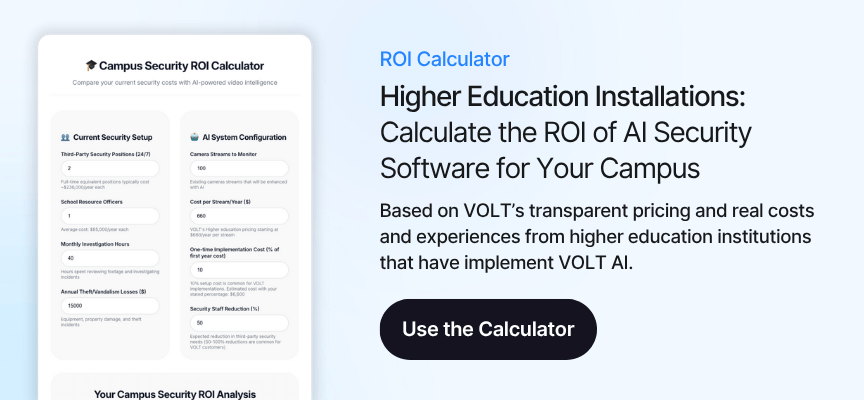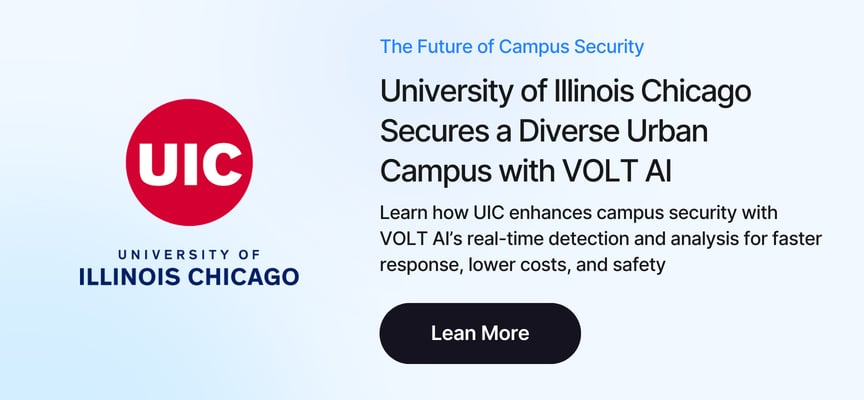Featured Snippet Header
- Privacy-compliant campus public safety: Behavioral detection AI enables comprehensive security monitoring without biometric identification or facial recognition systems
- State law compliance: Modern AI security solutions adapt to varying state privacy requirements, from restrictive biometric laws like Illinois BIPA to permissive surveillance regulations
- Real-time threat detection: Advanced computer vision analyzes movement patterns, clothing descriptions, and suspicious behaviors to identify potential security incidents instantly
- Legal compliance assurance: SOC2 Type II compliance and encrypted data handling ensure campus public safety systems meet federal privacy standards
- Operational effectiveness: Human-verified alerts eliminate false positive fatigue while maintaining continuous monitoring across entire campus networks
Campus public safety leaders face an increasingly complex challenge: protecting students and staff while respecting individual privacy rights and complying with strict state biometric laws. The traditional approach of hiring more security personnel or installing basic camera systems no longer addresses the sophisticated security challenges facing today's higher education institutions.
Modern universities need intelligent campus public safety solutions that can monitor vast areas continuously without compromising student privacy or violating state regulations. This balance between comprehensive security and privacy protection has become a defining issue for campus public safety professionals nationwide.
Learn from real campus safety professionals using AI security.
The Campus Public Safety Privacy Challenge
Campus public safety leaders face mounting pressure to enhance security measures while navigating an increasingly complex legal landscape. State laws regarding biometric data collection and facial recognition vary significantly across the country, creating compliance headaches for multi-campus institutions and challenging traditional approaches to campus public safety.
Illinois's Biometric Information Privacy Act (BIPA) represents one of the strictest approaches to biometric data protection in the United States. The law prohibits collecting, storing, or using biometric identifiers without explicit written consent, with penalties of $1,000 per violation and $5,000 for intentional violations. Other states like California, Texas, and Washington have implemented similar but less restrictive measures.
These regulatory differences force campus public safety directors to choose between comprehensive safety measures and legal compliance. Traditional facial recognition systems, while effective for identification, often violate state privacy laws and create liability risks for educational institutions.
Understanding Biometric vs. Behavioral Detection in Campus Public Safety
The distinction between biometric and behavioral detection systems is crucial for both compliance and effectiveness in campus public safety operations. Biometric systems identify individuals through unique physical characteristics like facial features, fingerprints, or iris patterns. These systems create permanent digital profiles that can be stored, searched, and matched across databases.
Behavioral detection systems analyze actions, movements, and patterns without identifying specific individuals. These campus public safety systems focus on detecting suspicious activities, unusual behaviors, or potential threats rather than determining who is performing those actions.
Detection Method | Data Collected | Privacy Risk | Campus Public Safety Compliance |
Facial Recognition | Biometric templates, facial geometry | High - permanent identification | Restricted in IL, CA, WA |
Behavioral Analysis | Movement patterns, clothing descriptions | Low - no personal identification | Compliant in all states |
Gait Recognition | Walking patterns, posture data | Medium - potentially identifying | Varies by implementation |
Object Detection | Weapons, suspicious items | Minimal - no personal data | Universally compliant |
How AI-Powered Behavioral Detection Enhances Campus Public Safety
Modern AI security systems can provide comprehensive campus public safety monitoring without collecting biometric data. These systems use advanced computer vision algorithms to analyze video feeds and identify potential security concerns through behavioral patterns, transforming reactive security approaches into proactive protection.
The technology focuses on detecting specific activities rather than identifying individuals. When a potential threat is detected, the system tracks the person's movement using clothing descriptions, gait patterns, and general physical characteristics without creating biometric profiles. This approach maintains effective campus public safety while preserving privacy.
Advanced systems like VOLT AI use sophisticated machine learning models to distinguish between normal and suspicious behaviors. The technology can identify weapons being brandished, detect fights breaking out, recognize medical emergencies, and flag unauthorized access to restricted areas \- all critical components of comprehensive campus public safety.
Calculate the ROI of AI Security Software for Your Campus.
Privacy-Preserving Tracking Capabilities for Campus Public Safety
Effective campus public safety requires the ability to track potential threats across multiple camera zones. Traditional systems lose subjects when they move between camera views, creating dangerous blind spots in security coverage that compromise campus public safety effectiveness.
Modern behavioral detection systems maintain continuous tracking without biometric identification, addressing this critical campus public safety challenge. The technology uses contextual clues like clothing color, body size, and movement patterns to follow subjects across camera networks.
Core campus public safety tracking capabilities include:
- Clothing-based identification: Systems recognize unique clothing combinations and patterns to maintain subject continuity across campus areas
- Behavioral signatures: Walking patterns, posture, and movement styles provide identification without biometric data collection
- Temporal correlation: Timeline analysis connects activities across different locations and camera views for comprehensive campus public safety coverage
- Environmental awareness: Systems understand campus layout and normal traffic patterns to identify anomalies that might compromise campus public safety
State Privacy Law Compliance for Campus Public Safety Systems
Understanding state-specific privacy requirements is essential for campus public safety leaders implementing AI systems. Each state approaches biometric data protection differently, creating a complex regulatory landscape for multi-campus institutions managing campus public safety across state lines.
The most restrictive states require explicit written consent before collecting any biometric data for campus public safety purposes. Moderate states allow biometric collection with proper notice and data protection measures. Permissive states provide broader surveillance authority while still requiring appropriate data handling procedures.
State Category | Key Requirements | Biometric Restrictions | Campus Public Safety AI Compliance |
Restrictive (IL, WA) | Written consent required | Complete prohibition without consent | Behavioral AI fully compliant |
Moderate (CA, TX, NY) | Notice and data protection | Limited collection with safeguards | Behavioral AI fully compliant |
Standard (Most States) | Basic privacy protections | General surveillance regulations | Behavioral AI fully compliant |
Permissive (AL, FL, GA) | Minimal restrictions | Broad law enforcement authority | Behavioral AI fully compliant |
Real-World Campus Public Safety Implementation Success
The University of Illinois Chicago (UIC) implemented behavioral detection technology across 142 camera streams to address campus public safety challenges while complying with Illinois's strict biometric privacy laws. The system provides real-time alerts for weapons detection, medical emergencies, and suspicious activities without collecting facial recognition data, demonstrating effective privacy-compliant campus public safety.
UIC's campus public safety implementation demonstrates how behavioral AI can replace expensive third-party security services while maintaining privacy compliance. The system detected multiple real security incidents, including an individual carrying a concealed weapon in a crowded area where human observers missed the threat, significantly enhancing overall campus public safety effectiveness.
Maryville University chose behavioral detection over facial recognition specifically to address privacy concerns from faculty and staff while maintaining robust campus public safety protocols. The system provides comprehensive campus monitoring while respecting community privacy preferences and avoiding potential legal complications.
Campus Public Safety Operational Benefits Beyond Privacy Compliance
Privacy-compliant AI security systems often provide superior operational benefits compared to biometric alternatives for campus public safety operations. These systems focus on detecting actionable security events rather than simply identifying individuals, leading to more relevant alerts and faster response times that enhance overall campus public safety. Beyond major incident prevention, these systems deliver daily campus security wins that justify their investment through routine operational improvements.
Human verification of AI-detected incidents eliminates false positive fatigue that plagues many campus public safety operations. Trained security professionals review each alert before escalation, ensuring that campus public safety teams only respond to genuine threats.
Operational advantages for campus public safety include:
- Reduced false alarms: Human verification eliminates nuisance alerts that cause response fatigue in campus public safety teams
- Faster response times: Real-time behavioral detection enables immediate threat identification and response, improving campus public safety outcomes
- Resource optimization: Automated monitoring reduces personnel requirements while increasing coverage area for campus public safety operations
- Investigation efficiency: Automated tracking and timeline generation accelerate incident investigation processes for campus public safety teams
Technical Architecture for Campus Public Safety Privacy Compliance
Privacy-compliant AI security systems require careful architectural design to ensure data protection while maintaining operational effectiveness for campus public safety applications. These systems must process video data locally or encrypt it during transmission to prevent unauthorized access to sensitive information.
Edge-based processing keeps video analysis on campus premises, reducing privacy risks associated with cloud-based systems while maintaining campus public safety effectiveness. Local processing also improves response times by eliminating network latency and ensuring continuous operation during internet outages - critical factors for reliable campus public safety operations.
Data encryption protects any information transmitted to cloud-based analysis systems. SOC2 Type II compliance ensures that security providers maintain appropriate data handling procedures and security controls required for campus public safety applications.
Integration with Existing Campus Public Safety Infrastructure
Modern AI security systems integrate seamlessly with existing camera networks, eliminating the need for hardware replacement or major infrastructure upgrades in campus public safety implementations. This compatibility reduces implementation costs and deployment timelines while preserving existing technology investments.
The integration approach focuses on enhancing current campus public safety capabilities rather than replacing functional systems. Schools can gradually expand AI coverage across campus while maintaining their existing security operations and procedures.
Read our Complete Guide to AI-Powered Campus Security Systems.
Addressing Campus Public Safety Stakeholder Concerns
Campus public safety leaders must address concerns from multiple stakeholders when implementing AI security systems. Students, faculty, parents, and administrators each have different priorities and concerns regarding privacy and security measures that affect campus public safety policies.
Transparent communication about system capabilities and limitations helps build stakeholder confidence in campus public safety initiatives. Explaining the difference between behavioral detection and biometric identification addresses privacy concerns while demonstrating the system's security benefits.
Key stakeholder communication points for campus public safety:
- Students: Emphasize privacy protection and the system's focus on behavior rather than identification in campus public safety operations
- Faculty: Highlight compliance with state privacy laws and the absence of biometric data collection in campus public safety systems
- Parents: Demonstrate improved campus safety without compromising student privacy rights through enhanced campus public safety measures
- Administrators: Present cost-benefit analysis showing operational savings and liability reduction from effective campus public safety implementation
Legal Compliance Across Different States for Campus Public Safety
State privacy laws vary significantly in their approach to surveillance technology and biometric data collection, creating challenges for campus public safety compliance across multiple jurisdictions. Security leaders must understand these differences when selecting and configuring AI security systems for multi-campus campus public safety operations.
Restrictive states like Illinois require explicit consent for biometric data collection and impose significant penalties for violations that could affect campus public safety budgets. Permissive states may allow broader surveillance capabilities but still require appropriate data handling procedures for campus public safety systems.
Behavioral detection systems provide a compliance solution that works across all state jurisdictions for campus public safety applications. These systems avoid biometric data collection entirely, eliminating regulatory risks while maintaining effective security coverage.
Adapting to Changing Campus Public Safety Regulations
Privacy regulations continue to evolve as legislators respond to advancing technology and changing public attitudes toward surveillance, directly impacting campus public safety policies. Security systems must be flexible enough to adapt to new legal requirements without requiring complete replacement of campus public safety infrastructure.
Modern AI platforms allow administrators to adjust detection parameters and data handling procedures to meet changing compliance requirements in campus public safety operations. This adaptability protects technology investments while ensuring ongoing legal compliance for campus public safety systems.
Making the Campus Public Safety Implementation Decision
Successful AI security implementation requires careful evaluation of campus-specific needs, existing infrastructure, and stakeholder requirements for effective campus public safety operations. Security leaders should prioritize systems that provide operational flexibility while ensuring privacy compliance in campus public safety applications.
Pilot programs allow universities to test AI security systems before full deployment of campus public safety solutions. These limited implementations provide valuable operational experience while demonstrating system capabilities to stakeholders and administrators.
The decision process should include input from legal counsel, IT departments, and campus security teams to ensure comprehensive campus public safety planning. This collaborative approach ensures that selected systems meet technical, legal, and operational requirements for effective campus public safety implementation.
Privacy-compliant AI security represents the future of campus public safety operations. These systems provide comprehensive threat detection and response capabilities while respecting individual privacy rights and meeting strict regulatory requirements. Universities that embrace behavioral detection technology can enhance campus public safety without compromising their values or legal compliance obligations, creating safer learning environments for the next generation.







